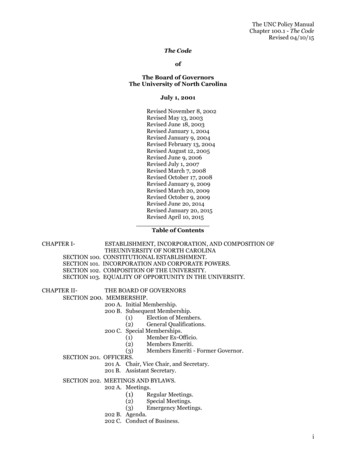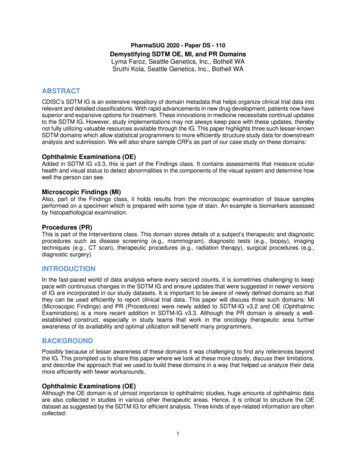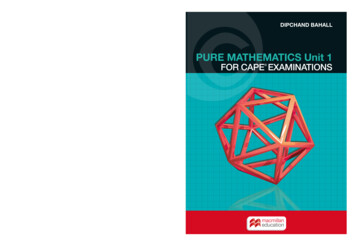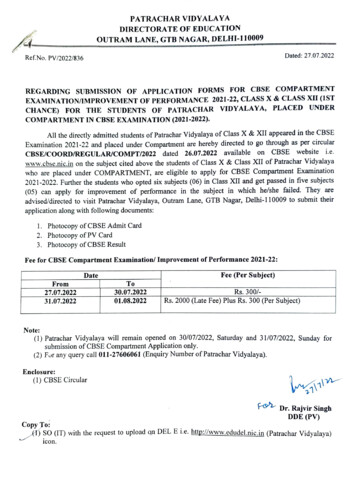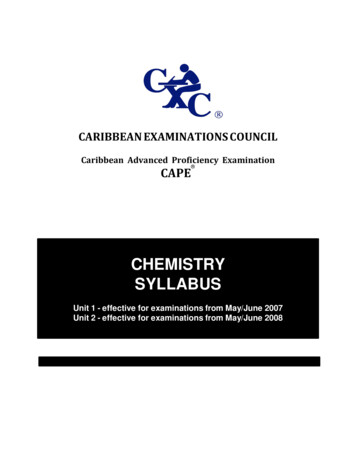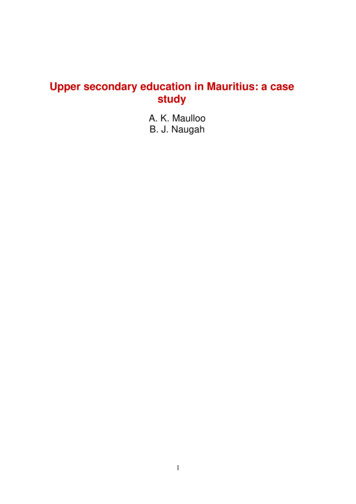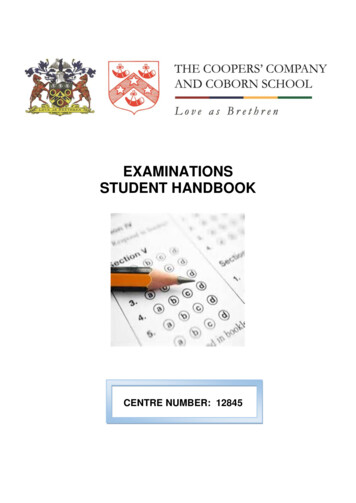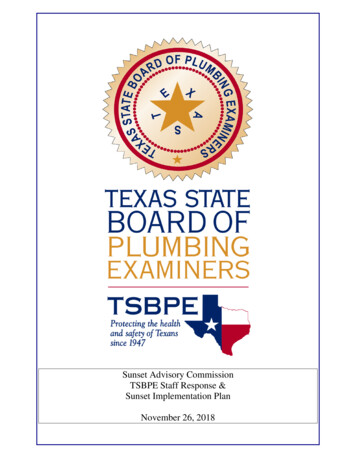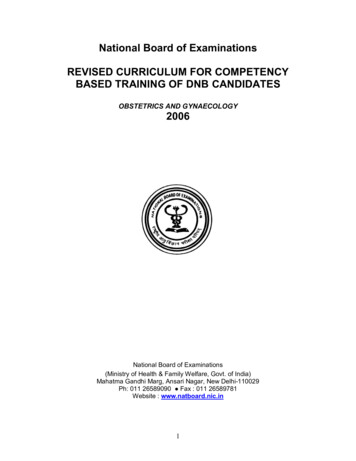
Transcription
National Board of ExaminationsREVISED CURRICULUM FOR COMPETENCYBASED TRAINING OF DNB CANDIDATESOBSTETRICS AND GYNAECOLOGY2006National Board of Examinations(Ministry of Health & Family Welfare, Govt. of India)Mahatma Gandhi Marg, Ansari Nagar, New Delhi-110029Ph: 011 26589090 Fax : 011 26589781Website : www.natboard.nic.in1
PrefaceThe National Board of Examination was established in 1975 with the primaryobjective of improving the quality of the Medical Education by elevating the level andestablishing standards of post graduate examinations in modern medicine on all Indiabasis. There are more than 450 N.B.E accredited institutions/ Hospitals , imparting DNBtraining programmes in 28 Broad specialties and 16 super specialties. Besides, there arePost-doctoral fellowship programmes in 14 specialties and Post-graduate dentalprogrammes in 9 specialties. In order to have standardized and quality training in all theaccredited hospitals, National Board of Examinations has a well structured curriculum.The curriculum is being revised periodically to incorporate newer topics and introducemore innovative training methods. The present curriculum has been revised by NationalBoard of Examinations’ experts and has details of the training objectives, schedule,methods, technical contents. There are lists of skills in various procedures/ surgicaltechniques which a DNB candidate must acquire during the training, reference and textbooks as well as the journals in the speciality. The curriculum also gives sample theoryquestions and common cases for practical skill assessment during training every sixmonths in the form of concurrent assessment. The guidelines for thesis andmaintenance of log book to record day to day activities carried out by the candidates arealso given.It is expected that the revised curriculum will be useful to the DNB consultants inorganizing the DNB training programmes in their respective hospitals. The DNBcandidates will also benefit from this document.2
ContentsGoalsObjectivesTentative schedule for trainingThesisMethods of trainingConcurrent assessment and final examinationAnnexureAnnexure-I, SyllabusAnnexure-II, Details of the skills to be acquired during the training periodAnnexure-III, Sample cases for presentation and discussionAnnexure-IV, Sample questions for concurrent assessmentAnnexure-V, Suggested list of books and journalsAnnexure-VI, Guidelines for writing thesisAnnexure-VII, Guidelines for local appraisers for six monthly assessmentAnnexure-VIII, Format for log book3
GoalA postgraduate student is required to acquire knowledge of Anatomy,Physiology, Pharmacology and Patho-physiology related to reproductive systemand be competent to manage pathological states related to it so as to work asSenior Resident (Junior consultant) at the end of DNB training.Objectives to be achieved by an individual at the end of 3 years of DNB training! Provide quality maternal care in the diagnosis and management ofAntenatal, Intra-natal & Post natal period of normal and abnormalpregnancy.! Provide effective & adequate care to the obstetrical and early neonatalemergencies.! Provide counseling and delivery of fertility regulation methods and performmedical termination of pregnancy.! Organize and implement maternal components in the “National HealthPrograms”! Develop adequate surgical skills to manage common obstetrical &gynecological problems. Applied basic sciences to Obstetrics &Gynaecology! Medical genetics- Elementary genetics as applicable to Obstetrics! Normal & abnormal pregnancy during Ante-natal, Intra-natal & post-natalperiod.! Benign and malignant Gynaecological disorders.! Gynaecological Endocrinology and infertility.! Operative procedures including endoscopy (diagnostic & therapeutic) andits related complications and their application in the field of Obstetrics &Gynaecology.! Common Medical & Surgical problems in association with Obstetrics &Gynaecology! Sound knowledge of interpretation of various laboratory investigations andother diagnostic modalities in Obstetrics & Gynaecology! Essentials of Pediatric and adolescent Gynaecology! Care of Postmenopausal women and Geriatric Gynaecology! Elementary knowledge of female Breast & its diseases.! Vital statistics in Obstetrics & Gynecology.! Anesthesiology related to Obstetrics & Gynaecology.! Reproductive and Child Health, family welfare & reproductive tractinfections! STD and AIDS & GOVERNMENT OF INDIA perspective on women’shealth related issues! Medico legal aspects in Obstetrics & Gynaecology! Asepsis, sterilization and disposal of medical waste! Use of newer information technologies (computer & internet)4
! Discuss the basic principles of anesthesiology and resuscitativemeasures.! Properly maintain medical records and know the medico legal aspects inrespect of Obstetrics & Gynecology.! Keep abreast with advances in the field of Obstetrics & Gynecology.! Plan educational programs in Obstetrics & Gynecology (with seniors) formedical & paramedical staff and also for the society.! Be familiar with modern methods of training & teaching! Demonstrate communication skills and compassionate attitude towardsthe patients.! Be familiar with research methodologiesTentative Schedule for three years of DNB TrainingEmphasis should be self-directed learning, group discussions, casepresentations and practical hands on learning. Student should be trained aboutproper history taking, clinical examination, advising/ ordering relevantinvestigations, their interpretation and instituting medical / surgical management,by posting the candidates in OPD, specialty clinics, wards, operation theaters,labour room, family planning clinics and other departments like neonatology,radiology, radiotherapy. The candidates must be trained to manage allemergency situations seen frequently.The student should attend to the duties (routine and emergency), Out patientdepartment, inpatients in the wards,Operation theater, labour rooms,write clinicalnotes regularly and maintain records. Ist Semester-working under supervision ofsenior resident & teaching faculty. 2nd & 3rd semester-carrying out minoroperations under supervision & assisting in major operations . 4th semesterposting in allied specialities (4 months) 5th & 6th semester- independent duties inmanagement of patient (including major operations under supervision ).Thedetails of the surgeries to be done during DNB training are given in annexure.The posting of DNB candidates in allied subjects should be done in fourthsemester for total 4 months as follows logyRadiology- 2 weeks- 2 weeks- 1 month- 1 month, (Surgical - 2 weeks, Medical -1 week, Radio therapy -1- 2 weeks- 2 weeks5
Assessments/ ExaminationsConcurrent examination/assessmentThe purpose of the concurrent assessment is to give regular feed back to the DNBcandidates about their performance and to prepare them for the final terminalexamination by giving them exposure to the examination pattern. As a part of theconcurrent evaluation, the DNB candidates will be assessed every six months by anindependent local appraiser selected by National Board of Examinations. This wouldinclude theory examination (100 marks of three hours duration) containing 10 shortstructured question related to the topics covered during the preceding six months by theaccredited hospital/institution.The practical examination (300 marks) will include long case, short case, spots,ward round, viva voce on the topics covered during the period by the hospital/institution.Final ExaminationTheory papers -Four (each of 100 marks) as follows:Paper-I Applied Basic SciencesPaper-II Obstetrics including Social Obstetrics & diseases of the newbornPaper III Gynaecology – including Gynae. pathology & OperativeGynaecologyPaper-IV Other disciplines related to Obstetrics & Gynaecology andContraception.10 Short Answer questions (10 marks each)Practical Examination:Long & short cases and OSCE should be given to the students for history takingand examination. Spot case should be given to the candidate in the presence ofthe examiner/s, to be examined (including history taking by the candidate) andassessed by the examiners Viva Voce on-Instruments, Pathology specimens,Drugs & X-rays, Sonography etc. , Pelvis and Foetal skull, Instruments,Pathology specimens, Drugs & X-rays, sonography etc., Family Planningmethods.6
ANNEXURE- I, THEORY SYLLABUSFirst Year1.Basic Sciences! Normal & abnormal development, structure and function of (Female &male) urogenital system and female breast! Applied Anatomy of female genito-urinary system, abdomen, pelvis, pelvicfloor, anterior abdominal wall, upper thigh inguinal ligament, inguinalcanal, vulva, rectum and anal canal! Physiology of spermatogenesis! Endocrinology related to male and female reproduction(Neurotransmitters)! Anatomy & physiology of urinary & lower gastrointestinal (Rectum/ analcanal) tract,! Development, structure & function of placenta, umbilical cord & amnioticfluid! Anatomical & physiological changes in female genital tract duringpregnancy! Anatomy of fetus, fetal growth & development, fetal physiology & fetalcirculation.! Physiological & Neuro-endocrine changes during puberty, adolescence,menstruation, ovulation, fertilisation, climacteric & menopause! Physiological changes during pregnancy, including systemic changes incardiovascular, hematological, renal, hepatic and other systems! Biophysical and biochemical changes in uterus and cervix duringpregnancy and labour! Pharmacology of drugs used during pregnancy, labour, post partum periodin reference to their absorption, distribution, excretion, (hepatic)metabolism, transfer across the placenta, effect of the drugs (used) onlabour, on fetus, their excretion through breast milk! Mechanism of action, excretion, metabolism of identified drugs used inthe management of gynaecological disorders! Role of hormones in Obstetrics & Gynaecology! Markers in Obstetrics & Gynaecology – Non neoplastic and NeoplasticDiseases! Pathophysiology of ovaries, fallopian tubes, uterus, cervix, vagina andexternal genitalia in healthy and diseased conditions.! Normal and abnormal pathology of placenta, umbilical cord, amniotic fluidand fetus! Normal and abnormal microbiology of genital tract . Bacterial, viral ¶sitic infections responsible for maternal, fetal and gynaecologicaldisorders.! Humoral and cellular immunology in Obstetrics & Gynaecology! Gametogenesis, fertilisation, implantation & early development of embryo7
! Normal pregnancy, physiological changes during pregnancy, labour andpuerperium.! Immunology of pregnancy.! Lactation.2 Clinical ObstetricsAntenatal Care-Prenatal care of normal pregnancy including examination,nutrition, immunization & follow up counseling.Intrapartum Care! Normal labour – mechanism & management.! Partographic monitoring of progress of labour, recognition of abnormallabour and its appropriate management.! Induction and augmentation of labour! Maternal & fetal monitoring in normal & abnormal labour and itsappropriate management! Electronic foetal monitoring!3. New Born – Conduct of Normal delivery including IIIrd stage!!!!Neonatal resuscitationCare on new born : Normal and high risk new born (including NICU care)Birth asphyxiaBreast feeding practice ,counseling and importance of breastfeeding.Problems in breast feeding and their management.4. Clinical Gynaecology! Epidemiology and etiopathogenesis of gynaecological disorders! Diagnostic modalities and management of common benign and malignantgynaecological diseases (diseases of the genital tract):! Fibroid uterus! Endometriosis & adenomyosis! Endometrial hyperplasia! Genital prolapse (uterine & vaginal)! Cervical erosion, cervicitis, cervical polyps, cervical neoplasia.! Vaginal cysts, vaginal infections, vaginal neoplasia (VIN)! Benign ovarian pathologies! Malignant genital neoplasia – of ovary, fallopian tubes, uterus, cervix,vagina, vulva and gestational trophoblastic diseases, Ca Breast.8
5. Infertility– Evaluation and management!!!!!!History taking ,examination and investigationsMale infertilityManagement of immunological factors of infertilityTubal MicrosurgeryMethods of ovulation inductionIntroductory knowledge of Assisted Reproductive Techniques (ART)6. Reproductive tract infections prevention, diagnosis & treatment!!!!Sexually transmitted diseasesHuman Immunodeficiency virusGenital tuberculosisOther infections7. Family Welfare & Demography! Definition of demography and its importance in Obstetrics andGynaecology! Various methods of male and female contraception! Knowledge of contraceptive techniques (including recent developments)! Provide adequate services to service seekers of contraception includingfollow up.! Medical termination of pregnancy : MTP act, its implementation, providingsafe and adequate services.7. Research and Dissertation! Recognize, the research project, objective of study: design the study withappropriate statistical validity of the size of the sample! Learn the use of library and review the literature.Second Year1. Clinical Obstetrics! Identification and management of complications of pregnancy – abortions,ectopic pregnancy, gestational trophoblastic disease, hyperemesisgravidarum, multiple pregnancy, antepartum hemorrhage, pregnancyinduced hypertension, preclampsia, eclampsia, other associatedhypertensive disorders, anemia, Rh incompatibility, diabetes, heartdisease, renal & hepatic diseases, preterm pregnancy and post termpregnancy, intrauterine fetal growth retardation.hydramnios, oligoamnios,premature rupture of membranes, recurrent pregnancy loss.9
! Neurological, hematological, dermatological diseases, immunologicaldisorders and other medical & surgical disorders/ problems associatedwith pregnancy,! Diagnosis of contracted pelvis, Cephalo-pelvic disproportion and theirmanagement.! Evaluation of fetal & maternal health in complicated pregnancy by makinguse of diagnostic modalities including modern ones (USG, Doppler,Electronic monitors) and plan for safe delivery for mother and fetus.Identifying fetus at risk & its management.! Infections in pregnancy (Bacterial, viral, fungal, protozoal)-Malaria,Toxoplasmosis, Rubella, Cytomegalovirus Herpes, HIV, Hepatic viralinfections (B,C etc.), Sexually transmitted infections (STDs), Mother tofetus transmission of infections,! Identification & management of fetal malpositions and malpresentations! Management of pregnancies complicated by medical, surgical (with otherspecialities as required) & gynaecological diseases.Anemia, hematologicaldisorders, Respiratory, Heart, Renal, Liver, skin diseases, GastroIntestinal, Hypertensive, Autoimmune, Endocrine disorders, AssociatedSurgical Problems. Acute Abdomen (surgical emergencies – appendicitis& Gastrointestinal emergencies). Other associated surgical problems.,Gynaecological disorders associated with pregnancy- congenital genitaltract developmental anomalies, gynaepathologies- fibroid uterus,Carcinoma Cervix, genital prolapse etc.Hematological problems inobstetrics including coagulation disorders. Use of blood and bloodcomponents/ products.2. Intrapartum Care! Identification and management of intrapartum complications, Cordpresentation, cord prolapse , abruptio placentae ,complications of 3rdstage of labour- retained placenta, inversion of uterus, rupture of uterus,post partum hemorrhage. Management of primary & secondary postpartum hemorrhage, Post-partum collapse, amniotic fluid embolism! Identification & management of genital tract trauma- perineal tear,episiotomy complications! Management of critically ill women3. Post Partum! Normal and abnormal purperium- sepsis, thrombophlebitis, mastitis,breast abscess , psychosis, deep vein thrombosis10
4. Operative ObstetricsPG students must have performed reasonable number of routine proceduresand assisted/ observed uncommon procedures.! Decision-making, technique & management of complications! Vaginal instrumental delivery, Caesarean section, Obstetric.hysterectomy, destructive operations, manipulations (External cephalicand internal podalic version, manual removal of placenta etc.)! Medical termination of pregnancy – safe abortions-selection of cases,technique & management of complications. MTP law.! Maternal Child Health MCH programs, Social Obstetrics & Vital statistics,Recent advances in Obstetrics.5. New Born!!!!Neonatal hyper-bilirubinemia investigations & managementBirth trauma- detection & managementDetection and management of fetal/ neonatal malformationManagement of common neonatal problems6. Clinical Gynaecology! Diagnosis and surgical management of clinical conditions related tocongenital malformations of genital tract. Reconstructive surgery ingynaecology.! Intersex, ambiguous sex and chromosomal abnormalities.! Reproductive endocrinology- Evaluation of Primary/ SecondaryAmenorrhea, management of hyperprolactinemia, Hirsutism, Chronic anovulation, Polycystic Ovarian Disease, thyroid and other endocrinedysfunctions.! Principles of radiotherapy and chemotherapy in gynaecologicalmalignancies, Choice, schedule of administration & complications of suchtherapies.! Rational approach in diagnosis and management of endocrine,abnormalities such as: menstrual abnormalities, amenorrhea (primary/secondary), dysfunctional uterine bleeding, Polycystic ovarian disease,hyperprolactinemia (galactorrhea), hyperandrogenism, thyroid-pituitaryadrenal disorders! Urological problems in gynaecology – diagnosis and management of Urinary tract infection, Urogenital fistulae, Incontinence, Other Urologicalproblems,! Orthopaedic problems in gynaecology! Menopause : management (Hormone replacement therapy) andprevention of its complications11
! Endoscopy (Laparoscopy Hysteroscopy)! Diagnostic & simple therapeutic procedures (PG students must be trainedto do these procedures)! Introduction to recent advances in operative procedures.7. Operative Gynaecology!!!!!!!Abdominal & vaginal hysterectomySurgical procedures for genital prolapseSurgical treatment for fibromyomaSurgical treatment for endometriosisSurgical treatment for ovarian pathology (cysts)Surgical treatment for adnexal (tubal) pathologySurgical treatment for urinary & other fistulae, urinary incontinence8. Family welfare planning & demography! Statistics regarding maternal mortality, perinatal mortality/ morbidity, birthrate, fertility rate.! Organizational and operational aspects of National health policies &programs in relation to population and family welfare includingReproductive & Child Health9. Male infertility! History taking, examination and investigation! Causes and management of male infertility! Introductory knowledge of indications and procedures of AssistedReproductive Techniques in relation to male infertility problems.10. Health of Adolescent Girls and Post Menopausal Women! Recognize importance of good health of adolescent and postmenopausalwomen.! Identification and management of health problems of postmenopausalwomen.! Understanding and planning and intervention program of social,educational and health needs of adolescent girls and menopausal women.12
11. Reproductive Tract and “HIV” Infection! Epidemiology of Reproductive Tract Infection and HIV infection in Indianwomen of reproductive age group! Cause, effect and management of these infections! HIV infections in pregnancy, its effects and management.! Relationship of reproductive tract infections & HIV with gynaecologicaldisorders! Planning and implementation of preventive strategiesThird Year1. Medical Genetics! Basic medical genetics including cytogenetics! Pattern of inheritance! Chromosomal abnormalities- types, incidence, diagnosis, managementand recurrence risk.! General principles of teratology! Screening, counseling and prevention of developmental abnormalities.! Birth defect- genetics, teratology and counseling.! Prenatal diagnosis (of fetal problems & abnormalities) and treatment –Fetal therapy.2. Operative Gynaecology! Operative Endoscopy! Recent advances in Operative gynaecology3. Medicolegal aspects! Knowledge and correct application of various acts and laws whilepracticing obstetrics and gynaecology, particularly MTP act andsterilization.! Knowledge of importance of proper recording of facts about history,examination findings, investigation reports and treatment administered inall patients.! Knowledge of steps recommended for examination and management ofrape cases.! Knowledge of steps to be taken in the event of death of a patient or astillbirth13
4. Environment and Health! Concept of safe disposal of human body fluids and other materials! Universal precautions to be taken in examining and carrying surgicalprocedures for the prevention of HIV and other diseases.! Effect of environment of pregnancy outcome.14
ANNEXURE-II, DETAILS OF THE SKILLS TO BE ACQUIRED DURING THETRAINING PERIODS.noName of procedureNumber of procedureAs ct of normal VaginaldeliveryPerineal Infiltration & PudendalblockEpisiotomyVentouse deliveryForceps deliveryManagement of Genital tractinjuriesExploration of CervixLower Segment CaesarianSectionManual Removal of PlacentaBreech vaginal deliveryExternal Cephalic VersionDelivery of twinsManagement of shockManagement of PostpartalhemorrhageCervical circlageAmnio infusionFAMILY PLANNINGIntra Uterine ContraceptionDevice InseReproductive TractInfectionson/ removalFemale sterilizationPost Partum andIntervalSuction & EvacuationGYNAECOLOGYPAP’S SmearWet smear examintionPost Coital TestEndometral biopsyEndometrial AspirationDilatation andAs firstassistantIndependently undersupervision5(1st yr) 15(2nd yr) 20(3rdyr)10 (Ist yr)5 (Ist yr)10 (Ist yr)15/20/255 (Ist yr)10 (Ist yr)15/20/255 (Ist yr)5 (Ist yr)5 (Ist yr)210 (Ist yr)5 (IInd yr)5 (IInd yr)210/15/205 (III yr)2 (3rd year)5 (Ist yr)10 (Ist yr)5 (IInd yr)10(2nd)/20(3rdyr)5 (III yr)10 (III 0/20/3010/10/105/5/510/10/1010/10/1010/10/10
5253545556Curettage/Fractional CurettegeCervical BiopsyCryo/ electrocoutery of cervixHystero salpingographyDiagnostic laparoscopyOpening & closing of abdomenOperations for utero vaginalprolapseOperations for Ovarian tumorsOperation for ectopic pregnancyVaginal hysterectomyAbdominal hysterectomyMyomectomyRepair of complete perineal tearRepair of cervical tearCaesarean hysterectomyInternal iliac ligationUterine & Ovarian Artery ligationDestructive operationsReposition of inversion uterusAmnio centesisVenesectionColposcopyLoop Electro Surgical esisEndoscopic surgeryRepair of genital fistulaeOperations forurinaryincontinenceRadical operations forgynaecological 55/5/510/10/102 (3rd year)-10/10-/-/2-/-/2-/-/2-/-2-/-/2
ANNEXURE –III, SAMPLE CASES FOR PRESENTATION AND DISCUSSIONLONG CASESObstetrics- Normal Term Pregnancy!!!!!!!!!!!!!!!Pregnancy Induced HypertensionDiabetesAnaemiaHeart DiseaseAntepartum HemorrhageJaundiceMalpresentationsPrevious Caesarean sectionBad Obstetrical History (Recurrent Preterm)/ (Recurrent abortions)Intrauterine growth restrictionPost dated pregnancyRh negative pregnancyMultiple pregnancyHydramniosIntra Uterine Death(IUD)Gynaecology!!!!!!!!!!Fibroid all typesAbnormal Uterine BleedingsMalignanciesInfertilityProlapsePost Menopausal Bleedings(PMB)Ovarian tumourFistulaeAdnexal massesAmenorrhoea – primary/secondary17
SHORT CASESObstetrics!!!!!!!AbortionsEctopic pregnancy (post operative)Cervical incompetencePuerperalPost LSCS (Caesarean Section)Early pregnancyMolar PregnancyGynaecology!!!!!!!Vaginal dischargePruritis vulvaeCervical erosion30 Perineal tearVulvar ulcerWhite lesions of vulvaObesity / Hirsutism18
ANNEXURE-IV, SAMPLE QUESTIONS FOR SIX MONTHLY !!Vascular supply & lymphatic drainage of female genital organsAnatomy of ureterDevelopment of placentaConstitution & functions of amniotic fluidFetal circulationPhysiology of menstruationDiagnosis of ovulationNormal vaginal floraIron metabolism during pregnancyPhysiology of third stage of labourMissed Intrauterine contraceptive devicePartographic assessment of labourConservative management of ectopic pregnancyManagement of 3rd stage of labourManagement of Premature rupture of membranes at 32 weeks ofgestation30 years Primigravida is admitted at 30 weeks pregnancy with painlessepisode of bleeding per vagina, discuss the managementComplications of Rh isoimmunizationFeto maternal hemorrhageMaternal to fetal transmission of HIVAntepartum management of HIV patientMethods of ovulation inductionScreening of carcinoma cervixManagement of post menopausal bleedingManagement of breech presentation at 38 weekManagement of early pregnancy with Intrauterine Contraceptive DeviceManagement of patient antepartum haemorrage at 36 wks of pregnancyMedical abortionEmergency contraceptionIncompetant OsManagement of atonic postpartal hemorrhageUSG in first trimesterInvestigations of a female with history of recurrent Ist trimester pregnancylossesConservative surgical management of prolapse uterusWork up of primary amenorrhea at 18 years.Recent advances in management of IUGRScreening for Down’s SyndromeDefine deep transverse arrest, discuss its managementArrest of after coming head of breechVentouse deliverySurgical management of postpartum hemorrhageAntenatal fetal surveillance19
!!!!!!!!!!!!!!!!!!!!Postcoital bleeding – ManagementEarly USG markers of chromosomal congenital malformationsGestational trophoblastic diseaseRecent advances in hormonal contraceptivesStaging laparotomy for ovarian tumourMale contraceptionHemoglobinopathiesInjectable contraceptivesGestational diabetes mellitusNewer oral contraceptive pillsManagement of puberty menorrhagiaIndications and complications of hysteroscopyHormone releasing devicesPolycystic Ovarian DiseaseHirsutismShort notes on Selective Estrogen Receptive Modulators (SERMs)Recent concepts on Hormone Replacement TherapyUreteric injuriesWork up of a 45 year old woman with urinary incontinencePre Natal Diagnostic Test Act (PNDT)20
ANNEXURE- V, BOOKS AND JOURNALS WHICH THE CANDIDATE MUST READOBSTETRICS!!!!!William’s ObstetricsTurnbull’s ObstetricsFernado Arias- Practical guide to High Risk pregnancy & deliveryDe Sweit- Medical Disorders in pregnancyD.K. James- High risk pregnancy management optionsGYNAECOLOGY!!!!!!Telinde’s operative GynecologyNovak’s – Textbook of GynaecologySperoff Leon’s – Clinical Gynaecology Endocrinology & InfertilityJeffcoate’s Principles of GynaecologyStudd- Progress in Obstetrics & GynaecologyBonner- Recent advances in Obstetrics & GynaecologyLIST OF BOOKS- MUST REFER!!!!!!Danforth’s Obstetrics & GynaecologyDewhurst Text book of Obstetrics & Gyneacology for post graduatesShaw’s text book of Operative GynaecologyShaw’s, Stanton & Souter GynaecologyKistner’s GynaecologyCoppelson Gynaecological OncologyLIST OF JOURNALS- INDIAN! Journal of Obstetrics & Gynaecology of IndiaLIST OF JOURNALS- FOREIGN!!!!!!Obstetrics & Gynaecology SurveyObstetrics & Gynaecology Clinics of North AmericaClinical Obstetrics & GynaecologyBritish journal of Obstetrics & GynaecologyContraceptionInternational Journal Obstetrics & Gynaecology21
ANNEXURE-VI, GUIDELINES FOR WRITING THESIS/DISSERTATIONResearch shall form an integral part of the education programme of all candidatesregistered for Diplomat of NB degrees of the Board. The Basic aim of requiring thecandidates to write a thesis/dissertation is to familiarize him/her with researchmethodology. The members of the faculty guiding the thesis/dissertation work for thecandidate shall ensure that the subject matter selected for the thesis/dissertation isfeasible, economical and original.GuidelinesI.The thesis may be normally restricted to the size to 100 pages. To achieve this,following points may be kept in view;(i)(ii)(iii)(iv)Only contemporary and relevant literature may be reviewed.The techniques may not be described in detail unless anymodification/innovations of the standard techniques are used andreference may be given.Illustrative material may be restricted.Since most of the difficulties faced by the residents relate to the work inclinical subject or clinically oriented laboratory subjects the following stepsare suggested:! For prospective study, as far as possible, the number of cases should be suchthat adequate material, judged from the hospital attendance, will be availableand the candidate will be able to collect the case material within a period of 6-12months so that he/she is in a position to complete the work within the stipulatedtime.! The objectives of the study should be well defined.! As far as possible, only clinical or laboratory data of investigations of patients orsuch other material easily accessible in the existing facilities should be used forthe study.! Technical assistance, wherever necessary, may be provided by the departmentconcerned. The resident of one speciality taking up some problem related tosome other speciality should have some basic knowledge about the subject andhe/she should be able to perform the investigations independently, whereversome specialised laboratory investigations are required a co-guide may be coopted from the concerned investigative department, the quantum of laboratorywork to be carried out by the candidate should be decided by the guide and coguide by mutual consultation.! The Clinical residents may not ordinarily be expected to undertake experimentalwork or clinical work involving new techniques, not hitherto perfected or the useof chemicals or radio isotopes not readily available. They should however, befree to enlarge the scope of their studies or undertake experimental work on theirown initiative but all such studies should be feasible
National Board of Examinations REVISED CURRICULUM FOR COMPETENCY BASED TRAINING OF DNB CANDIDATES OBSTETRICS AND GYNAECOLOGY 2006 National Board of Examinations (Ministry of Health & Family Welfare, Govt. of India) Mahatma Gandhi Marg, Ansari Nagar, New Delhi-110029 Ph: 011 26589090 Fax : 011 26589781 Website : www.natboard.nic.in
